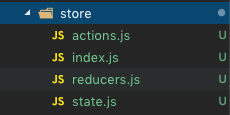在react中使用redux
写在前面
在react中使用redux一直是一大痛点,redux 过于复杂 所以后来出现了mobx,当然今天不说mobx,今天说下redux(自以为很复杂的redux)。
redux的基本用法就是:用户发出 Action,Reducer 函数算出新的 State,View 重新渲染。但是现在有一个问题就是,异步操作怎么办?Action 发出以后,Reducer 立即算出 State,这叫做同步;Action 发出以后,过一段时间再执行 Reducer,这就是异步。
怎么才能 Reducer 在异步操作结束后自动执行呢?这就要用到新的工具:中间件(middleware)。本次用到的中间件有redux-thunk,redux-logger
-
安装四个npm包
npm install --save redux react-redux redux-thunk npm install --save-dev redux-logger
redux 和 react-redux 是必须的 redux-thunk可以帮你实现异步action。redux-logger可以实现监测redux的变化
-
文件结构

然后我们在详细介绍一下每个文件所做的事情
-
actions.js
export const SET_PAGE_TITLE = "SET_PAGE_TITLE"; export const SET_INFO_LIST = "SET_INFO_LIST"; export function setPageTitle(data){ return {type: SET_PAGE_TITLE, data: data} } export function setInfoList (data) { return (dispatch, getState) => { // 使用fetch实现异步请求 // 请求发起前可以先dispatch一个加载开始状态 // 例如 dispatch({ type: SET_LOADING_TYPE, data: "loading" }) window.fetch('/api/getInfoList', { method: 'GET', headers: { 'Content-Type': 'application/json' } }).then(res => { return res.json() }).then(data => { let { code, data } = data if (code === 0) { dispatch({ type: SET_INFO_LIST, data: data }) } // 请求结束可以dispatch一个加载结束状态 // 例如 dispatch({ type: SET_LOADING_TYPE, data: "loaded" }) // 还可以区分一下成功或者失败 }) } }可以看出第一个action 是直接返回了一个action:{type: SET_PAGE_TITLE, data: data} ,而第二个则返回了一个函数,这个函数接受两个参数 dispatch 与 getState , dispatch可以在异步加载完成以后发出一个action。在不使用redux-thunk这个中间件的时候dispatch接受的只能是一个action , 使用这个中间件就可以接受上文所说的参数,也就实现了Reducer 在异步操作结束后自动执行。
-
reducers.js
// reducers.js // combineReducers 工具函数,用于组织多个reducer,并返回reducer集合 import {combineReducers} from 'redux' import defaultState from './state' import {SET_PAGE_TITLE,SET_INFO_LIST} from './actions' //一个reducer 就是一个函数 function pageTitle ( state = defaultState.pageTitle, action){ // 不同的action 有不同的处理逻辑 switch (action.type) { case SET_PAGE_TITLE: return action.data default: return state } } function infoList (state = defaultState.infoList, action){ switch (action.type) { case SET_INFO_LIST: return action.data default: return state } } export default combineReducers({ pageTitle, infoList }) -
state.js
/** 此文件存放state默认值 同步数据:pageTitle 异步数据:infoList(将来用异步接口获取) */ export default { pageTitle:"首页", infoList:[] } -
index.js
// index.js // applyMiddleware: redux通过该函数来使用中间件 // createStore: 用于创建store实例 import { applyMiddleware, createStore } from 'redux' // 中间件,作用:如果不使用该中间件,当我们dispatch一个action时,需要给dispatch函数传入action对象;但如果我们使用了这个中间件,那么就可以传入一个函数,这个函数接收两个参数:dispatch和getState。这个dispatch可以在将来的异步请求完成后使用,对于异步action很有用 import thunk from 'redux-thunk' import logger from 'redux-logger' // 引入reducer import reducers from './reducers.js' // 创建store实例 第一个参数是reducer集合(reducers),第二个参数初始化的store(initialState),第三个参数是applyMiddleware函数,来使用中间件 ,因为只在reducer里面初始化了值,所以这里并没有传入初始化store的值 let store = createStore( reducers, applyMiddleware(thunk,logger) ) export default store -
入口文件
import React from 'react'; import ReactDOM from 'react-dom'; import {BrowserRouter as Router,Route} from "react-router-dom"; import {Provider} from "react-redux"; import store from './store' import App from './App' import * as serviceWorker from './serviceWorker'; ReactDOM.render( <Provider store={store}> <Router > <Route component={App} /> </Router> </Provider> , document.getElementById('root')); // If you want your app to work offline and load faster, you can change // unregister() to register() below. Note this comes with some pitfalls. // Learn more about service workers: http://bit.ly/CRA-PWA serviceWorker.unregister(); -
test.js
// Test.jsx import React, { Component } from 'react' import {Route,Link} from 'react-router-dom' // connect方法的作用:将额外的props传递给组件,并返回新的组件,组件在该过程中不会受到影响 import { connect } from 'react-redux' // 引入action import { setPageTitle, setInfoList } from '../store/actions.js' class Test extends Component { constructor(props) { super(props) this.state = {} } componentDidMount () { let { setPageTitle, setInfoList } = this.props // 触发setPageTitle action setPageTitle('新的标题') // 触发setInfoList action setInfoList([{data:1}]) } render () { // 从props中解构store let { pageTitle, infoList } = this.props // 使用store return ( <div> <div> <Link to="/courses/ii">Courses</Link> </div> <h1>{pageTitle}</h1> { infoList.length > 0 ? ( <ul> { infoList.map((item, index) => { return <li key={index}>{item.data}</li> }) } </ul> ):null } </div> ) } } // mapStateToProps:将state映射到组件的props中 const mapStateToProps = (state) => { return { pageTitle: state.pageTitle, infoList: state.infoList } } // mapDispatchToProps:将dispatch映射到组件的props中 const mapDispatchToProps = (dispatch, ownProps) => { return { setPageTitle (data) { // 如果不懂这里的逻辑可查看前面对redux-thunk的介绍 dispatch(setPageTitle(data)) // 执行setPageTitle会返回一个函数 // 这正是redux-thunk的所用之处:异步action // 上行代码相当于 /*dispatch((dispatch, getState) => { dispatch({ type: 'SET_PAGE_TITLE', data: data }) )*/ }, setInfoList (data) { dispatch(setInfoList(data)) } } } export default connect(mapStateToProps, mapDispatchToProps)(Test)代码的重点在connect函数。这个函数也是由react-redux提供的。使用它可以包装普通的展示组件(这里的Test——只负责展示数据),然后返回一个容器组件。connect函数通过第一个参数让展示组件订阅了来自store的数据;通过第二个参数让展示组件默认可以dispatch各种action。
applyMiddlewares()
applyMiddlewares是redux的原生方法,作用是将所有中间件组成一个数组,依次执行。
要注意的是中间件为顺序有要求,具体可以查看你下载的npm包介绍。
本次使用的redux-logger 必须放最后,不然可能监测不到正确的store



